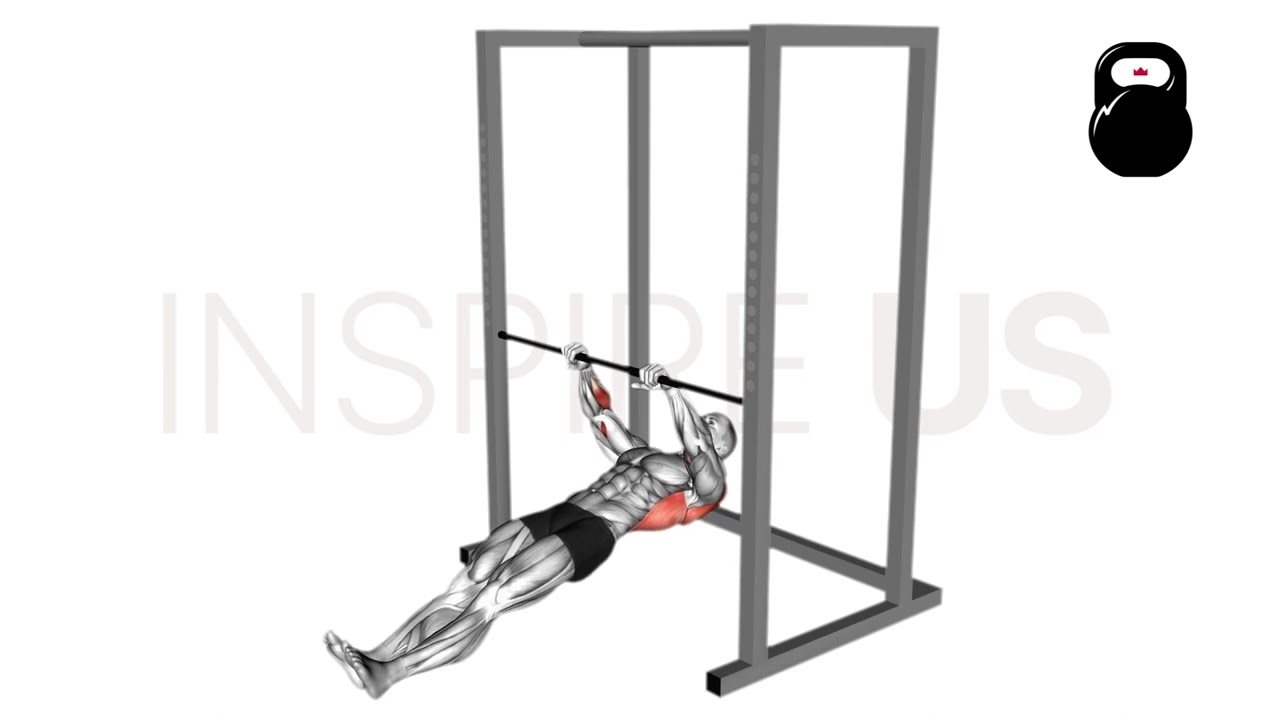Inverted Row: Benefits, Muscles Worked, and More
Occasionally also called a horizontal pull-up, the inverted row is a staple of calisthenics training programs for its efficiency at targeting the upper back muscles.
Being perhaps one of the closest exercises one can perform to a standard barbell row, inverted rows should be mastered by novice calisthenics athletes if they wish to maximize development of their pull muscles.
The inverted row - as one can guess - is performed in a similar manner to weighted rows, but with the athlete drawing themselves towards the bar, rather than the bar towards them. This necessitates that the athlete position themselves beneath the bar, and that they have access to a bar close to the ground.
What are Inverted Rows?
In technical examination, the inverted row is a bodyweight closed kinetic chain compound movement of moderate intensity and low complexity.
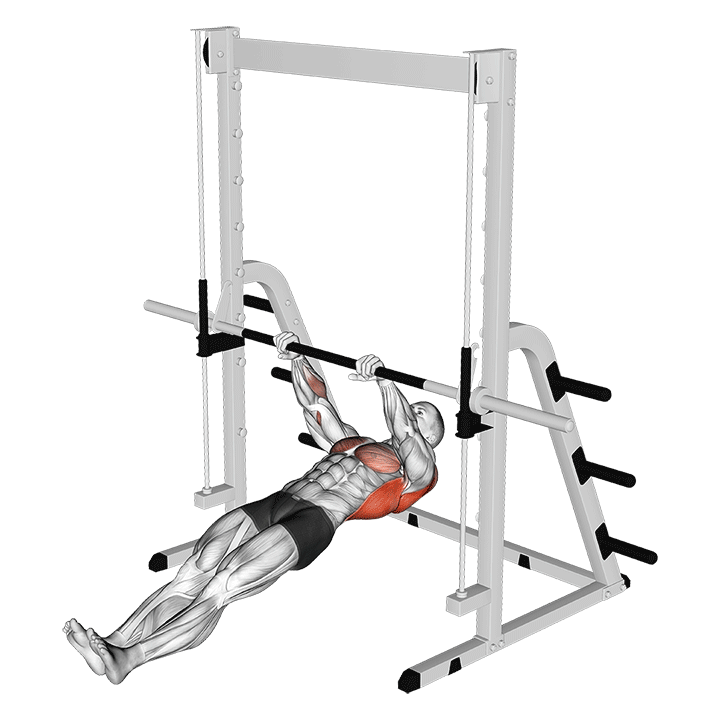
It is frequently performed for inducing hypertrophy or strength development of the upper back and biceps. Likewise, the inverted row is also occasionally employed to correct issues in scapular retraction or by novices who cannot yet perform a full pull-up.
To perform inverted rows in the traditional manner, a smith machine or racked barbell will be needed.
However, it is also possible to perform the exercise using parallettes, resistance bands or any other object suspended around arms-length over the ground. Unlike the pull-up, the feet will remain touching the ground so as to better support the body throughout an inverted row.
How to Do an Inverted Row
To perform an inverted row, the athlete will first position their chest beneath the bar, body facing upwards and hands set around shoulder-width apart in a pronated orientation along the bar. The legs should be fully extended before the body, acting solely as a source of balance alongside the core muscles.
Allowing their body to hang from their extended arms, the athlete will then contract their core and squeeze their back musculature.
As they do this, the elbows should bend, with the upper torso being pulled upwards between them. The body should form a diagonal line from chest to feet at the apex of the repetition, legs and hips fully extended.
Once the elbows are parallel to the sides of the torso, the athlete slowly reverses the motion and allows their upper body to drop back downwards, extending the elbows out.
When the arms are fully extended over the body once more, the repetition is complete.
Avoid flaring the elbows out excessively to the sides, as doing so can increase the risk of shoulder injury.
What Muscles Do Inverted Rows Work?
Inverted rows are a compound movement, meaning that more than one muscle group is involved in moving the body’s joints.
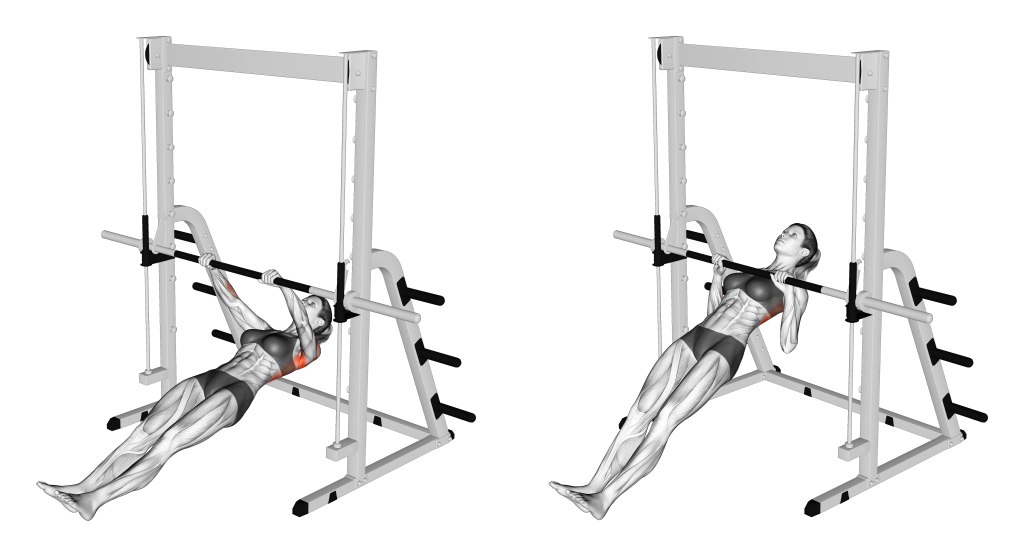
These muscles are divided according to the manner in which they contract, with mover muscles being contracted dynamically and stabilizers exhibiting static contraction.
Primary and Secondary Mover Muscles
In terms of the main muscles used during an inverted row, the latissimus dorsi, teres major and minor, trapezius and the rhomboids all play a primary role.
Alongside these (in a secondary capacity) are the biceps brachii, brachialis, brachioradialis and the posterior head of the deltoids.
Each muscle is contracted in a dynamic manner, meaning that the muscle will visibly shorten and lengthen through a specific portion of the inverted row’s range of motion. This equates to greater hypertrophy in comparison to the stabilizer muscles.
Stabilizer Muscles
Apart from the mover muscles, inverted rows will also isometrically work the abdominal muscles, the remaining two heads of the deltoids and the pectoral muscles.
Isometric or static contraction means that a muscle does not significantly alter its length while contracted. This is done so as to help stabilize joints and support the muscles that are being contracted dynamically.
What are the Benefits of Doing Inverted Rows?
Apart from being great at building all-around pulling strength, the inverted row is also great for achieving the following benefits.
One of the Few Bodyweight Horizontal Pulling Exercises
For bodyweight athletes, compound pulling exercises largely come down to either the pull-up or - for horizontal pulls - the inverted row.
This makes the inverted row unique, as while the pull-up has many distinct variations, the inverted row remains largely the same in nature, regardless of variation performed.
Horizontal pulling exercises are vital for building thickness and strength in the mid-back, especially in regards to the lower trapezius, teres muscles and the rhomboids.
Low Risk, Low-Impact and Suitable for Novices
Inverted rows are particularly useful as a safer and more low-impact alternative to many other horizontal pulling exercises.
Unlike barbell rows where the lower back is in a compromised position, the inverted row distributes most of the weight into the ground through the legs and feet. This greatly reduces the risk of lower back injuries - as well as joint impact in general.
Combining the inverted row’s low barrier of entry, low injury risk and forgivingness on the joints creates an exercise uniquely suited for novices - especially those without access to weightlifting equipment.
Excellent for Building the Biceps, Middle Back and Upper Back
The inverted row excels at working the muscles of the mid-back to a greater degree than its vertical pulling counterparts. This leads to a thicker back and generally stronger horizontal pulling strength.
Furthermore, specifically comparing the inverted row to the pull-up, the inverted row features significantly more biceps brachii recruitment, as well as greater activation of the rhomboids, teres muscles and lower trapezius.
High Capacity for Volume and Variation
Because inverted rows are relatively light and low-impact, performing them for high volume (as may be the case for bodyweight athletes) is more than possible.
Even with its greater capacity for volume notwithstanding, the inverted row also allows for athletes to further up the intensity of each repetition by simply changing the elevation of the bar off the floor.
The closer to the ground, the more difficult the exercise as more of the body’s weight is carried by the back.
Further variations that also change the manner in which the inverted row is performed do exist - all of which build upon a certain benefit that is already present within the conventional inverted row.
Common Inverted Row Mistakes
Although the inverted row is quite simple, there are a few mistakes that one should look out for to avoid injury.
Bending the Legs or Drawing the Knees Up
The inverted row is primarily performed so as to target the muscles of the back.
However, if performed with the knees drawn upwards so as to support the body, less of the body’s weight will be turned into resistance against these back muscles. This defeats the purpose of the exercise.
In order to get the most out of each inverted row repetition, ensure that the legs remain straight and contribute no force whatsoever to the movement. They are meant to act solely as a source of stability and balance.
Beginning Too High or Too Low Beneath the Bar
For the best inverted row, performing the exercise with the bar over the chest at the start of the repetition is ideal. Beginning with the bar too high along the body can negate much of the muscles of the back, whereas one that is too low along the body may overly emphasize the elbow flexor muscles.
Incorrect Grip Width
During a conventional inverted row, the hands of the athlete should be set around shoulder-width apart so as to allow for a safe elbow angle to be adopted.
Too narrow and the range of motion may become unnecessarily large, and too wide may lead to impingement and injuries of the shoulder.
Because every athlete is physiologically different, we advise those unfamiliar with the inverted row to experiment with a shoulder-width grip to see what best fits them.
Flaring the Elbows
Apart from ensuring the hands are set at the correct width, the elbows themselves should also be angled correctly.
Avoid raising them above the shoulders as they are pointed out to the sides, as this can nonetheless still lead to impingement, even with the hands in the correct width.
Ideally, the elbows should be flared as little to the sides as possible, instead keeping aligned with the forearms and relatively close to the body throughout each repetition.
Alternative Exercises to the Inverted Row
If the inverted row isn’t quite hitting your back how you want - or you’ve progressed beyond needing it - try the three following alternatives out.
Pull-Ups
An especially important alternative for calisthenics athletes - the pull-up is a vertical pulling exercise that targets a similar pattern of muscles to the inverted row.
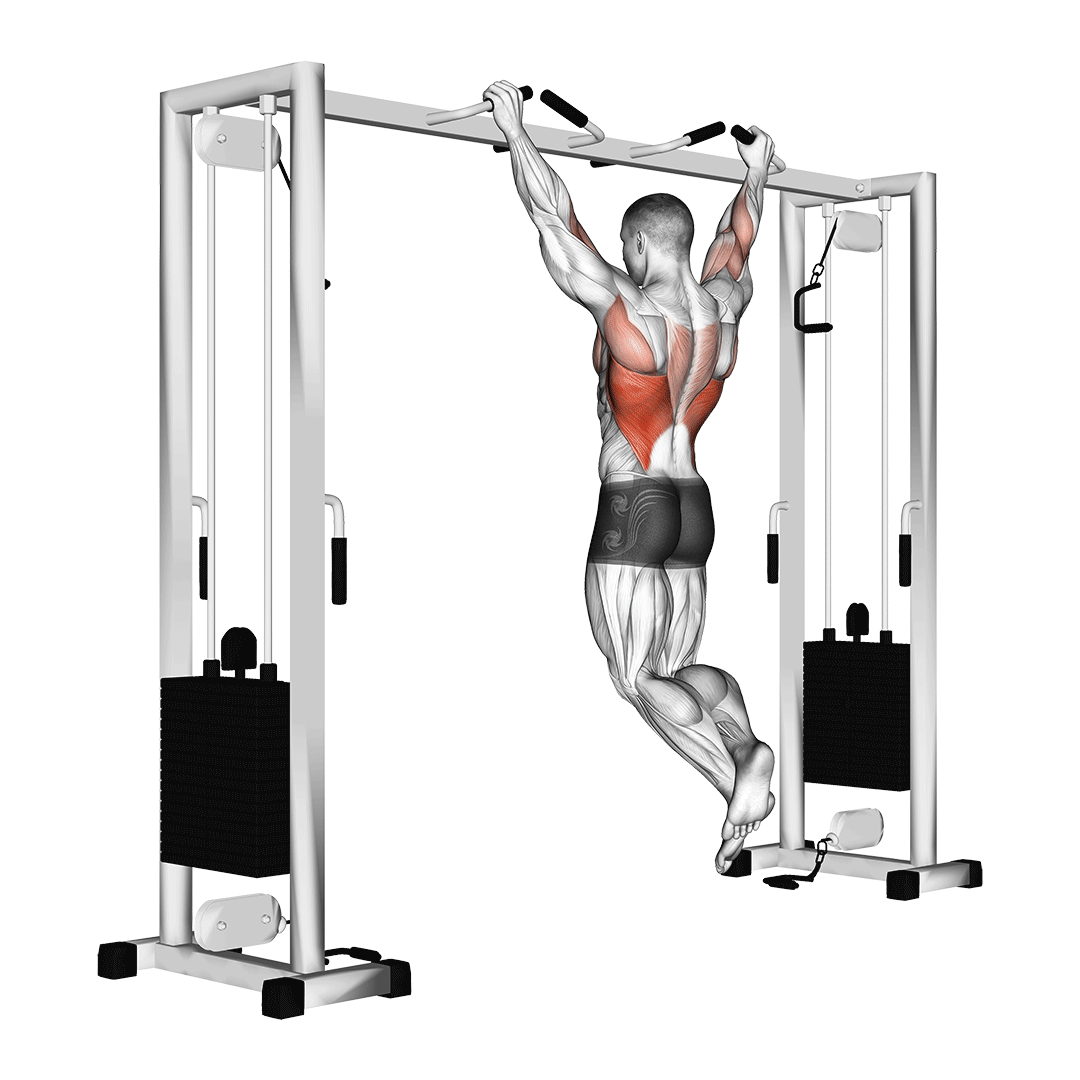
Unlike the latter, the exercise is performed with the athlete entirely suspended by their hands, creating a greater emphasis on the lats and a more intense repetition as a whole.
Pull-ups are the ideal alternative for bodyweight exercisers who find conventional inverted rows to be too easy, or for athletes seeking greater latissimus dorsi emphasis.
Feet-Elevated Inverted Rows
For an even more intense version of the inverted row, elevating the feet higher off the ground will force more of the body’s weight onto the back muscles.
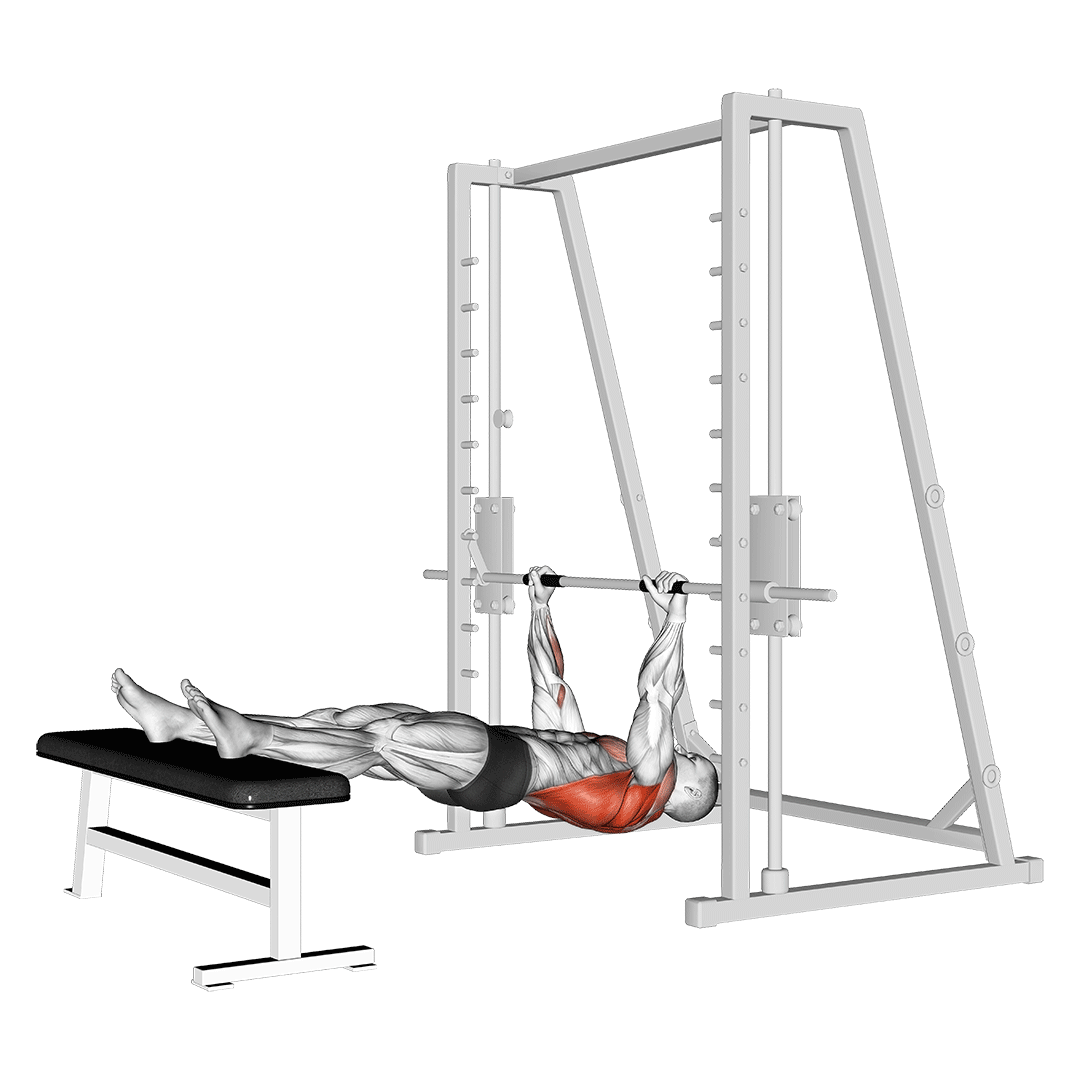
So long as the athlete is mindful of maintaining their range of motion, elevating the feet on a block or bench can make the inverted row an even more effective back exercise.
Even more advanced athletes can also lower the bar while elevating their feet, forming a decline angle with the body so as to maximize the intensity of each individual rep.
Parallel Bar Inverted Rows
For individuals without access to a straight bar or who find the double overhand grip uncomfortable, it is possible to perform inverted rows with the use of parallel bars instead.
Using parallel bars allows the lifter to instead perform the exercise with a neutral grip, shifting more emphasis towards the brachioradialis and brachialis muscles - as well as reducing the risk of injury even further.
Frequently Asked Questions (FAQ)
What are Inverted Rows Good for?
Inverted rows are excellent as a method of building strength and muscle mass throughout the mid-back.
When combined with pull-ups, they allow for a comprehensive back workout to be achieved without the use of free weights or resistance machines.
Are Inverted Rows as Good as Pull-Ups?
Although they target much the same muscle groups, the inverted row and pull-up are not quite comparable due to the difference in mechanics between the two.
The inverted row is considered a horizontal pull with considerably less complex and less difficult execution than the pull-up - of which is a vertical pull. Both exercises serve separate purposes within a back workout.
Are Inverted Rows for Beginners?
Yes - inverted rows are excellent for beginners. So long as proper form is followed, they can be the perfect introduction into back exercises as a whole.
In Conclusion
The inverted row is a highly effective inclusion into any back workout - but remember to also consider other options if possible. Exercises like the back row, lat pulldown and barbell shrug all target parts of the back that are less emphasized by the inverted row - and from different angles.
For the best results, remember to perform inverted rows alongside a number of other exercises that complement it. If you are a calisthenics athlete, try bodyweight bicep curls and scapular pull-ups as well.
References
1. Snarr, Ronald & Esco, Michael. (2013). Exercise Highlight: Inverted Row. Journal of Australian Strength and Conditioning. 21.
2. Snarr, Ronald & Nickerson, Brett & Esco, Michael. (2014). Effects of hand-grip during the inverted row with and without a suspension device: An electromyographical investigation. European Journal of Sports and Exercise Science. 3. 1-5.
3. Snarr, Ronald. & Michael R. Esco. (2013) "Comparison of electromyographic activity when performing an inverted row with and without a suspension device." Journal of Exercise Physiology Online 16, no. 6 Gale OneFile: Health and Medicine (accessed August 22, 2023).

